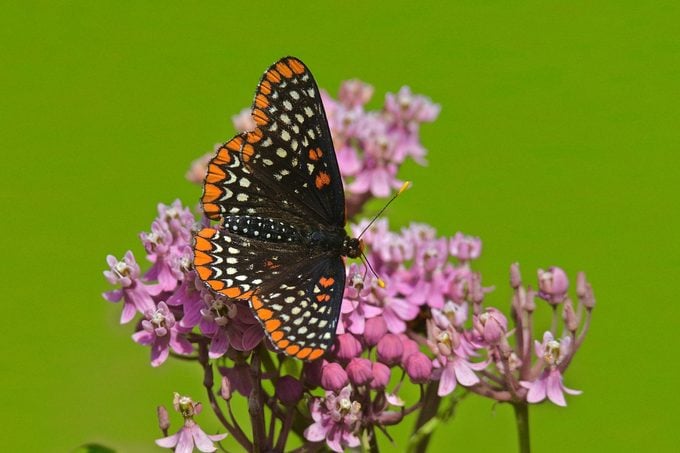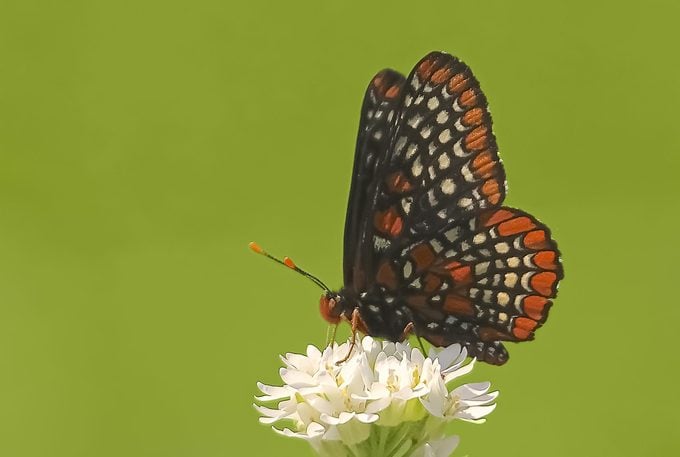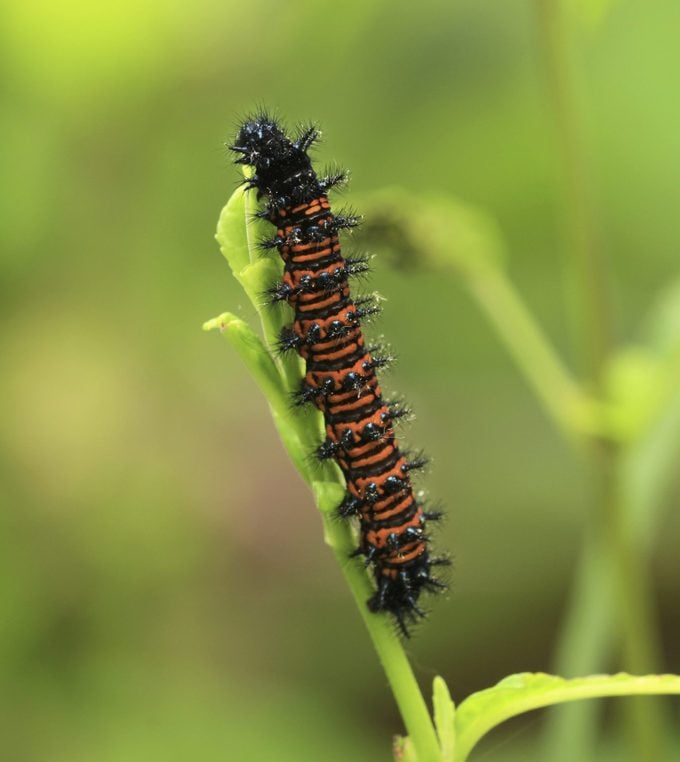How to Identify a Baltimore Checkerspot Butterfly
Updated: Mar. 01, 2024
See what Baltimore checkerspot butterflies and caterpillars look like. Plus, learn which host plants you should grow to support this species.
Baltimore Checkerspot Butterfly Identification

- Wingspan: 1 3/4 to 2 3/4 inches
- Markings: Black with a band of large orange spots along the wing edges and inner bands of white spots
- Range: Seen in the northeastern U.S. and southeastern Canada, and occasionally as far south as Arkansas and Alabama
- Habitat: Meadows, bogs and marshes in the northeastern range and open or wooded hillsides in the southwestern range
- Eggs: Start yellow and turn red
- Host Plants: Turtlehead, hairy beardtongue, English plantain and false foxglove
To spot a Baltimore checkerspot, look for a black butterfly with a band of large orange spots along the wing edges and inner bands of white spots. Typically, Baltimore checkerspot butterflies are found in the northeastern U.S. and southeastern Canada. Sometimes they travel as far south as Arkansas and Alabama. Their preferred habitat consists of meadows, bogs and marshes in the northeastern range, and open or wooded hillsides in the southwestern range.
Also important to note is the relative trickiness of finding the butterfly, even within its range. “The striking colors of the little Baltimore checkerspot make it hard to confuse with any other butterfly,” says Birds & Blooms contributor and butterfly expert Jill Staake. “Spotting it might take a bit of luck, though. It can be abundant in some local areas, while completely absent from others nearby.”

Jill notes that in Maryland, where the Baltimore checkerspot is the state butterfly, it’s become so uncommon that the state lists it as rare. Because their habitat is often disappearing in their range, the butterflies have become harder and harder to find.
Learn to identify more kinds of butterflies you might see.
Baltimore Checkerspot Caterpillar and Host Plants

Pick out a Baltimore checkerspot caterpillar by making note of its alternating bands of orange and black with rows of branchlike spines. Checkerspot eggs start yellow and turn red.
Find out what a monarch caterpillar looks like.
One way to help checkerspots, Jill says, is to plant their native host plant: white turtlehead. “As [white turtlehead] has become rarer, this species has also started using non-native English plantain, which many people pull as a weed from their garden,” she says.
Jill also explains that something as simple as leaving leaf litter can be beneficial to checkerspots. “This butterfly, which generally only has one brood per year, overwinters as a caterpillar,” she says. “They burrow into leaf litter in groups, hunkering down until the following spring. By preserving leaf litter in your yard, you help protect any overwintering caterpillars.”
About the Expert
Jill Staake‘s lifelong love of nature turned into a career during the years she spent working with native Florida butterflies, caterpillars, and other wildlife at the Museum of Science & Industry in Tampa, Florida. During this time, she helped to maintain 30+ acres of gardens and backwoods, all carefully cultivated to support the more than 20 species of butterflies displayed indoors and out. She now writes for a variety of publications and sites on topics like gardening, birding, and education, among others.
Sources
Why Trust Us
For nearly 30 years, Birds & Blooms, a Trusted Media Brand, has been inspiring readers to have a lifelong love of birding, gardening and nature. We are the #1 bird and garden magazine in North America and a trusted online resource for over 15 million outdoor enthusiasts annually. Our library of thousands of informative articles and how-tos has been written by trusted journalists and fact-checked by bird and garden experts for accuracy. In addition to our staff of experienced gardeners and bird-watchers, we hire individuals who have years of education and hands-on experience with birding, bird feeding, gardening, butterflies, bugs and more. Learn more about Birds & Blooms, our field editor program, and our submission guidelines.






















